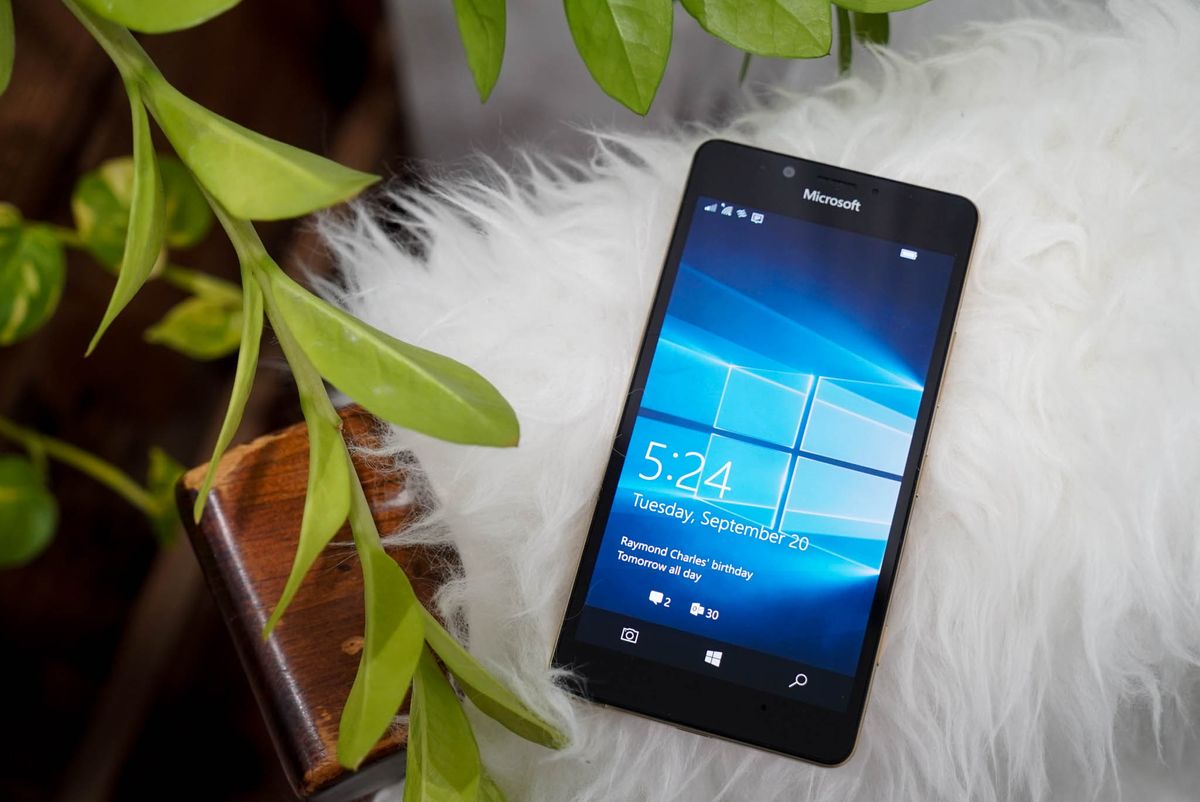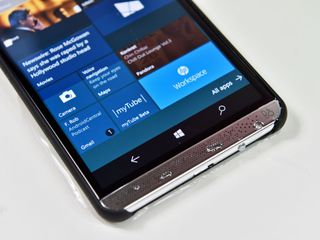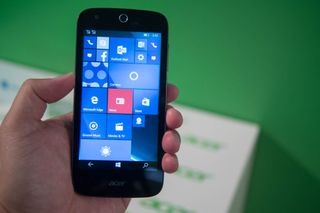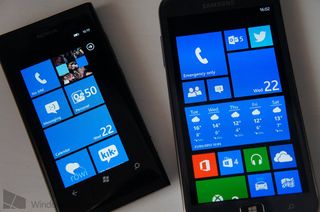Does Windows 10 Mobile have a future?
With all the work Microsoft is putting into Windows 10 on ARM and the CShell, what future is there for Windows 10 Mobile?

Microsoft's upcoming CShell for Windows 10 is a big deal, if only because it'll open the door to a whole new market of mobile devices, powered by full Windows 10 on ARM. CShell will allow hardware makers to build devices that are mobile-sized, but run full Windows 10 with a UI scaled to look just like Windows 10 Mobile, which would ultimately make our beloved mobile platform obsolete.
Let's be real here, Windows 10 Mobile has been out in the cold for a while now. Outside of upcoming Continuum improvements, which are thanks to CShell anyway, Microsoft hasn't detailed any Windows 10 Mobile features coming in the Creators Update. Some might suggest this is because Windows 10 on ARM will eventually be taking its place, and that's not so difficult to believe when you think about it. Why continue building an OS for phones that nobody uses when you can shove an OS used by millions of people onto the same device-type anyway? That's essentially what Windows 10 on ARM will achieve with CShell, if hardware makers pursue it.
So that leaves us with a daunting question, with CShell on the way, does Windows 10 Mobile have a future? While we can't know the answer for sure, it's always healthy to speculate and wonder, as we often do with Windows 10 Mobile. So where exactly could Microsoft be taking Windows 10 Mobile?
1. Do Nothing
Microsoft could simply opt to do nothing with Windows 10 Mobile and keep everything as-is for the foreseeable future. The company has said many times that Windows 10 Mobile is now an enterprise-focused OS, and if they wish to stay true to this claim they'll have to keep releasing updates and keep it on the market.

This is arguably the least exciting option, since Microsoft really isn't focused on Windows 10 Mobile as it is. We're yet to hear of any actual star features coming in the Creators Update for Windows 10 Mobile, and I'm starting to think we won't actually be getting any, outside of CShell and Continuum improvements of course, and even then we're not exactly sure if they're arriving with the Creators Update.
If Microsoft continue supporting Windows 10 Mobile as it is currently, we can likely expect the same treatment (or lack thereof) going forward. I'd much rather Microsoft reposition Windows 10 Mobile and give it a new breath of life.
2. Reposition it
So here's what I mean by reposition: make it so it's not just an OS for mobile phones. With CShell, this is absolutely a possibility. Microsoft can make it so Windows 10 Mobile can run on phones and laptops, scaling the UI where needed and allowing hardware makers to release lightweight laptops that run Windows 10 Mobile.
Get the Windows Central Newsletter
All the latest news, reviews, and guides for Windows and Xbox diehards.
This would ensure the platform stays alive, with new features and support for as long as Windows 10 is in development. It also means devices that are currently running Windows 10 Mobile, such as the Elite x3 and Lumia 950, can piggy back off of this new repositioning for a little while longer, at least until their hardware can no longer keep up with future mobile computing demands.

You may be asking yourself "but Zac, isn't Windows 10 Cloud basically this?" Good question, and I don't think so. As far as I know, Windows 10 Cloud is like any other normal Windows 10 desktop SKU, but without the ability to download programs from the web. Everything is routed through the Windows Store with the Cloud SKU, and that's fine. Otherwise, it's still full Windows 10.
Microsoft could reposition Windows 10 Mobile as an actual lightweight Windows 10 variant for hardware makers. Make it a free SKU for hardware makers, rename it from Windows 10 Mobile to Windows 10 Lite, and market it as a simple version of Windows for when you're on-the-go. It can work on phones, tablets and even low-end laptops.
This somewhat separates it from Windows 10 Cloud, as even though CShell will allow the Cloud SKU to scale to phones, it'll still be heavier than Windows 10 Mobile is currently.
3. Kill it
This is an obvious one, which likely makes sense to most people reading this article. Microsoft may simply opt to kill it once Windows 10 and CShell are a full-on thing. I mean, if Microsoft doesn't reposition the platform, there really isn't any need for it, right? It can't survive as a platform only for phones, it needs to adapt and expand.
Killing it wouldn't actually get rid of Windows 10 on phones, however. That's the magic of CShell — in theory it will allow full Windows 10 to run on phones. Microsoft would only really be killing one of the many Windows 10 SKUs, but deep down we'll know, and we'll suffer and cry regardless.

If Microsoft were to kill it, I don't think it'd be that bad of an idea in the long run. Sure, it'd seem like the end of the world for us dedicated fans, but not if Microsoft times it right. If Microsoft can maintain Windows 10 Mobile as-is for the next year or two, and then introduce Windows 10 with CShell and new phones running full Windows 10, the death of Windows 10 Mobile would simply be the next step in the tumultuous evolution of Microsoft's mobile platforms. It certainly wouldn't be as painful as the Windows Phone 7 to 8 transition.
And killing it would also likely be beneficial to the future of Windows on phones too. It'll make room for new full Windows 10-powered phones instead, which isn't bad.
4. Co-exist with full Windows 10 phones
This is also a viable option, but not one I'm expecting many people will be excited to hear. Keep Windows 10 Mobile alive and in-development alongside Windows 10 for phones, but make it an option for low-end devices. Let's be honest, full Windows 10 won't run on low-end phones, and that's where Windows 10 Mobile may be able to help.

This way, hardware makers can still make budget Windows 10 Mobile devices for the low-end of the price spectrum. This will hobble current high-end Windows 10 Mobile devices, but it'll all be for a greater good in the long run. But that'll split development resources at Microsoft (even with their size and money, there are only so many programmers to go around), aggravate the app developers Microsoft needs for the Windows Store, and just make things more complicated. Though it could just be a temporary solution for a few years until low-end hardware catches up to the demands of full Windows 10.
5. Does it really matter?
At the end of the day, Windows 10 Mobile is in use by less than 1% of the mobile market. Whatever Microsoft does with the platform, it really doesn't matter at this point. Microsoft could kill it, could evolve it, or they could turn it into a beautiful butterfly, but at the end of the day it won't matter as it's still in use by basically no one.
The only people affected by whatever Microsoft does to Windows 10 Mobile is us, the last group of crazy people who refuse to let this platform die. Perhaps we should let it die, as it'll make room for something else. I know we've done that before with Windows Phone 7, but there's basically no one left here on Windows 10 Mobile anyway, so why not let it die again?

I honestly think the future of Windows 10 on phones lies with Windows 10 coming to ARM. It may mean Windows 10 Mobile no longer has a place on the market, but in all honesty, as a Windows 10 Mobile user myself, I'm okay with that. I'd rather Microsoft "try again" than just give up altogether when it comes to mobile. It may mean leaving current adopters behind, but that's just something we'll have to accept if we want Microsoft to keep trying.
If you're tired of Microsoft constantly retrying its Mobile efforts, buy an iPhone or Android device. Microsoft's efforts extend to the likes of those platforms these days, with excellent and well built apps that'll make you think twice about getting a Windows 10 Mobile device to begin with. Give them a go if you don't want to risk a platform that might be "reset" again.
